Special thanks to Steve Ngok, Unica Yin, Wendy Ding for review and feedback.
Finite games can be played within an infinite game, but an infinite game cannot be played within a finite game. — James Carse
Venture capital is one of the driving forces of innovation, technology, and human progress. It helps innovators achieve great goals by organizing human, scientific, technological, and political resources.
Despite venture capitalism’s success in supporting businesses and entrepreneurship over the past decades, venture capital has shown its weakness. On the surface, the limitations come from the conflicting goals between the GPs and LPs, as well as the lack of alignment between founders and investors. In the equity market, most GPs are constrained by the finite years of the fund cycle (e.g., 10 years). In the crypto market, a large number of GPs suffer from much shorter fund cycles (sometimes as short as 1 or 2 years due to low listing barriers and market volatilities), and many fund managers are forced to dump their positions quickly. This phenomenon has led some fund managers to be criticized as “weak hands” or “flippers”.
In the equity market, an Initial Public Offering (IPO) is often considered a success of a venture-stage company. Most of the time, a fund’s primary goal is to invest in companies and sell at its IPO. Usually, it takes at least 5–7 years for a company to go public. Therefore, fund cycles are set to reflect this idea of helping an early-stage company through to its IPO. The problem of this approach is that if some company has a longer-term vision, then the fund could lose a bigger opportunity to be with the company and gain a much higher return from its post-IPO development and growth. This has been true for all of the greatest companies such as Netflix, Tesla, Apple, Google, and more. Recently, the Sequoia Fund recognized this problem. As a result, it’s canceling LP access to its seed and venture capital funds as described in a post. Instead, the Sequoia Fund invests in primary market deals from its secondary market fund, taking back control of venture-stage projects and the ability to hold their venture investments for as long as they want.
In the crypto market, a listing happens much faster than an IPO in the equity market. Most of the time, a cryptocurrency project goes public in its early stage (less than 3 years, sometimes within a few months after being conceived). Investors are lured to the juicy gains from listing hypes. Some crypto funds accept a 1-year fund cycle in order to get more LPs on board. However, a similar situation applies in the crypto market too — a successful Web3 venture takes more than one cycle to build, and when a project really succeeds, the return is far higher than a single hype period.
There are two types of misalignments. First, there is a misalignment between fund managers and fund LPs. Usually, the larger the knowledge gap between the GP and the LP, the more difficult a long fund cycle could become. Second, there is a misalignment between funders and fund managers. It’s always attractive to sell shares/tokens at listing events with a liquidity premium rather than wait for years before the project’s true value is built.
Given the different types of behaviors, the venture capital game is like the following.
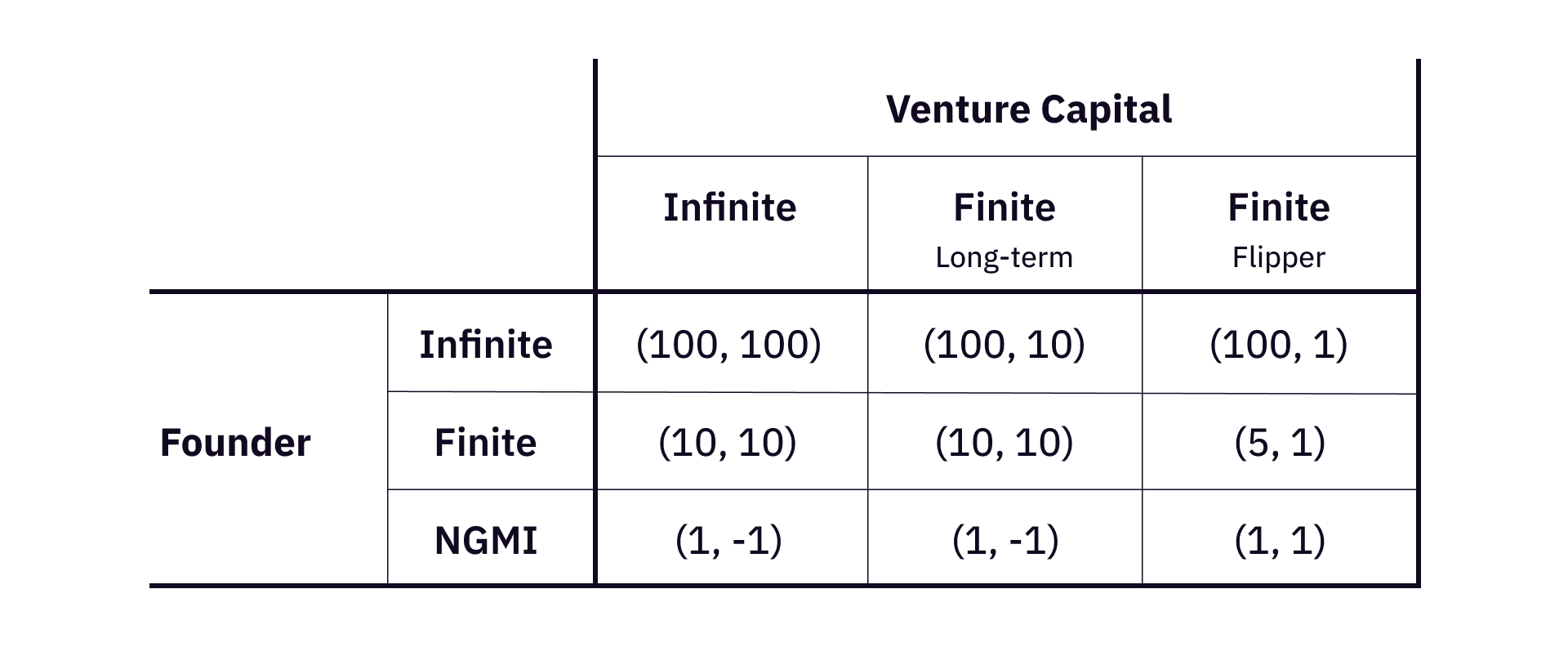
In the game, we consider a new kind of behavior — infinitism. Infinite games can be explained as games that are played not for winning, but for continuing the play (Carse). For founders, being infinite means playing an infinite game. For venture capital, being infinite means supporting founders to continue the infinite game.
There are many examples of infinite games from the founders’ side. Think about the following infinite games which we will come back again to examine later: develop a city, build a blockchain infrastructure for decentralized systems, make human-being a multi-planetary species, and the hacker movement.
How about infinitism of venture capital?
Technically, we can draw a spectrum of venture capital based on the fund cycle — from speculative, opportunity-driven funds to “evergreen” funds. From the spectrum, an infinite fund is simply a fund that extends its fund cycle to infinity.
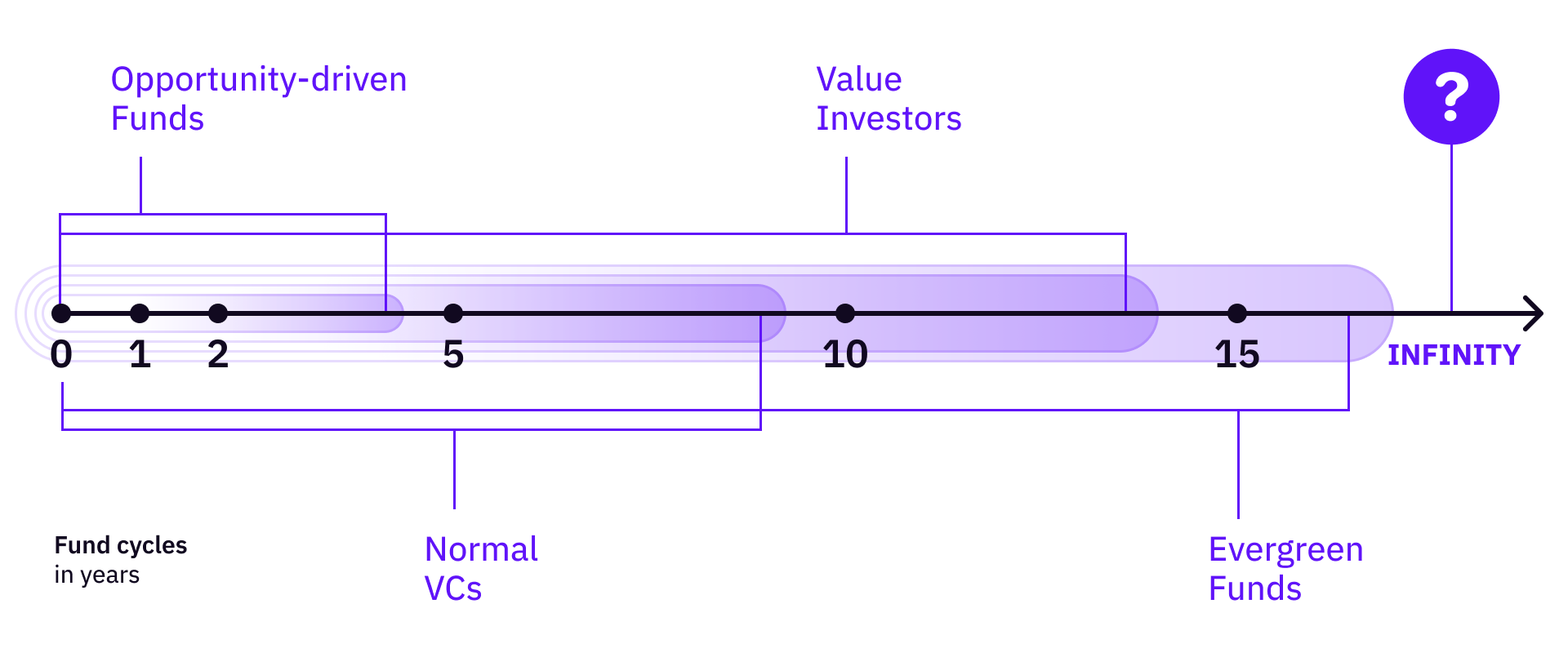
However, what does it mean for a venture capital fund to be infinite? How can a venture capital fund be infinite? Let’s explore a bit more!
Infinite Games and Sub-games
An infinite game contains sub-games. The number of possible sub-game of any infinite game is infinite. A sub-game itself can be either an infinite game or a finite game. Here is a table of some infinite games and their corresponding sub-games:
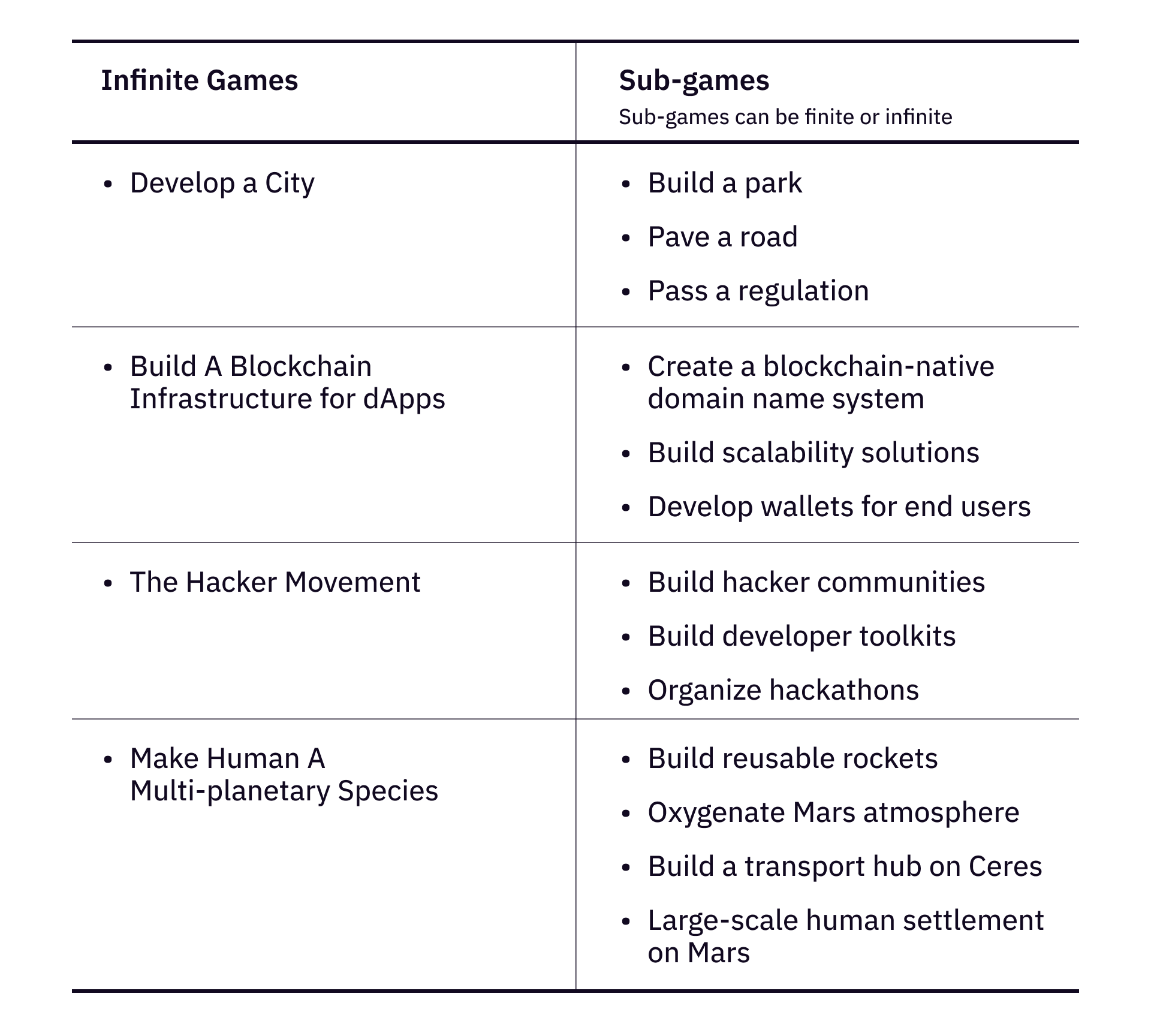
Infinite Funds — Funding Infinite Games
An infinite fund has an infinite fund cycle and invests in an infinite game by investing its sub-games. The sub-games can be finite games, but the infinite game is the purpose. To evaluate and compare the differences between an infinite fund and a finite fund, we can look at five metrics: the goals, investment motivations, exit strategies, fund cycles, and funding sources.
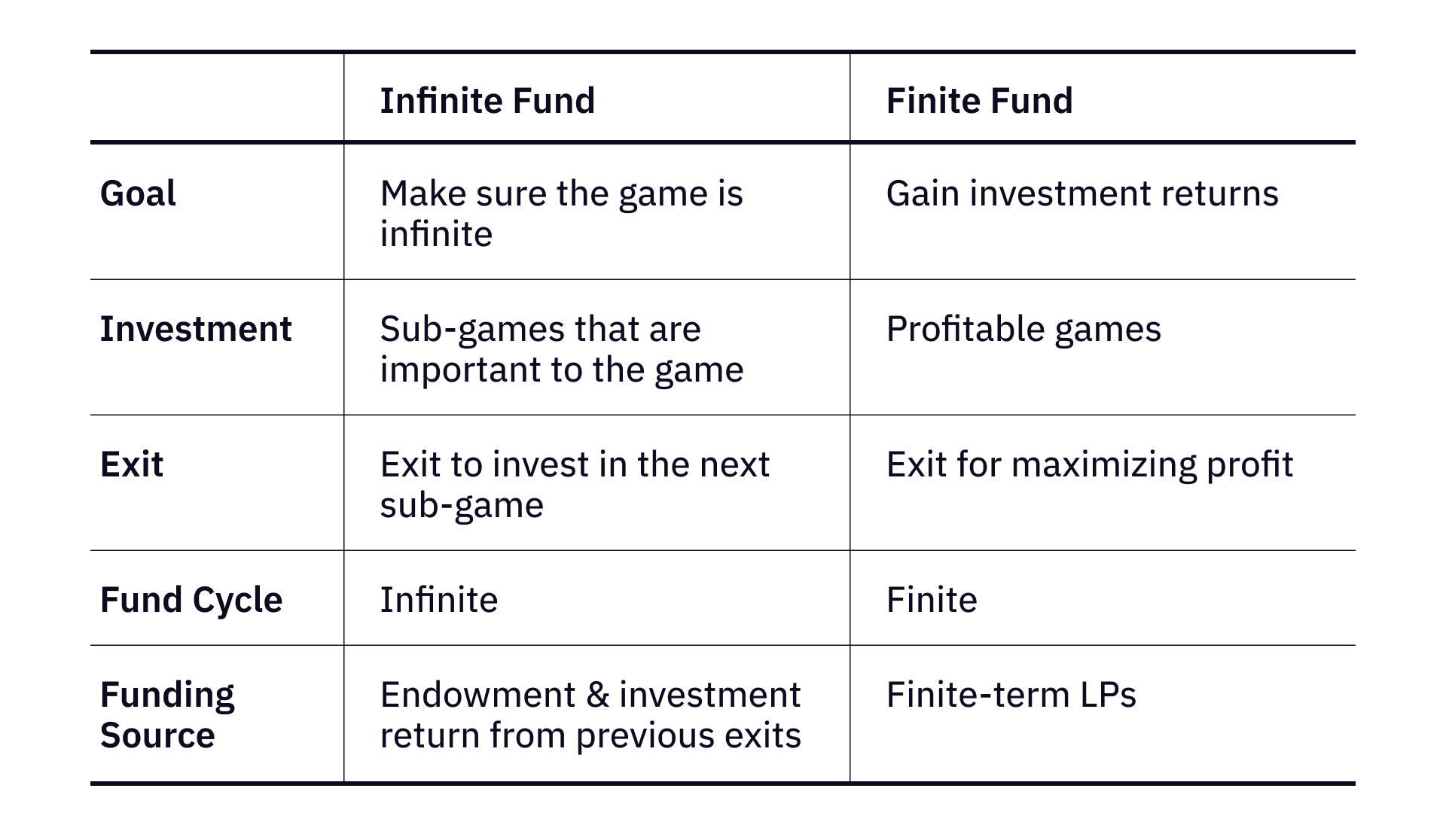
Nation-state treasuries are naturally infinite funds, because nation states are infinite games themselves, which (normally) aim to develop the nations into better-living places. To some extent, blockchain protocols are like nation states in that these protocols have their own governance rules enforced by code and the consensus among their communities. In the former case, the treasury is sustained by taxation. In the latter case, the foundation’s wealth comes from appreciation of their native-tokens and protocol-level income.
In the case of venture capital, endowment from organizations or people who want to unconditionally fund an infinite game is necessary to build an infinite fund. An endowment can come from multiple sources: the revenue of an organization (e.g. protocol fee of a decentralized project), donation, or token sale events. The fund sustains itself through re-investing all previous returns into the next sub-games.
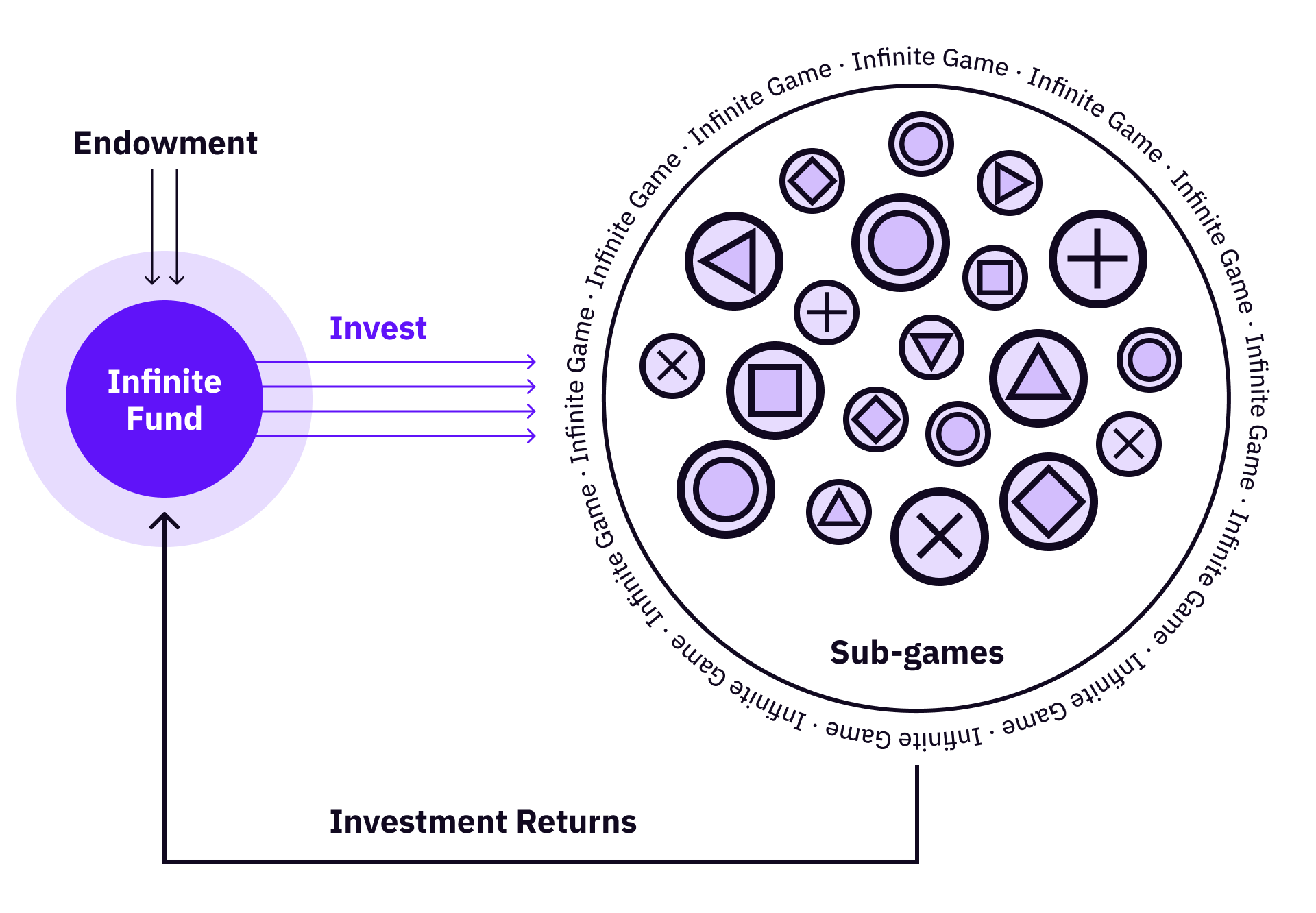
DoraHacks Ventures is designed as a hacker fund with an infinite fund cycle as part of DoraHacks to support the Hacker Movement. Binance Labs is supporting the development of the whole blockchain space with a combination of venture capital and a 8-week intensive Incubation Program, which is supposed to run indefinitely into the future.
Funding Public Goods with Infinite Funds
There is a class of valuable ventures that current venture capitals fail to capture — public good funding.
The value of public goods has been underestimated for a long time. Previously, public goods were developed by public authorities or non-profit organizations because public goods were recognized as efforts that could not profit. However, government funding is often inefficient and subject to attacks like corruption and political disruptions, and non-profit organizations often suffer from non-sustainability of funding. It is difficult for traditional DCF-based valuation methods to properly capture the value of something that is not profitable (in the fiat space) but good for the community. Therefore, in the past, venture capitals almost focused entirely on profitable businesses, leaving public goods in the dust.
DAOs are changing how public goods are organized and developed in the following ways:
- A DAO is able to organize and incentivize a decentralized network of contributors and users, avoiding friction costs and inefficiencies of centralized organizations. For example, a decentralized media can organize a decentralized network of contributors effectively.
- DAOs are able to distribute governance rights to their participants, including contributors, administrators, users, and funders. Governance rights are no longer concentrated among shareholders.
- DAOs discover governance value and community-driven value, potentially creating a legitimate way to give public goods proper valuations in the long-run.
Infinite funds can continuously fund public goods by funding public good DAOs.
Build Infinite Funds with Web3 Technology
Further mechanisms can be designed to add flexibilities of an infinite fund. There are already some practical solutions. LPs who join MolochDAO or The LAO get shares/loots from the DAOs. The Moloch mechanism allows rage quit if the collective fund is making bad decisions. However, the DAO itself is infinitely sustained if at least some of its members stay. Therefore, the Moloch funds can be considered as a class of infinite funds that do not have high entry barriers (it’s much easier to join a Moloch DAO than join the Sequoia Fund).
Another way to provide liquidity for infinite fund LPs is to tokenize the fund. Fund tokens can be evaluated based on the net asset value of the fund. Although the security token space is progressing slowly, strong players could make it possible when more attractive tokenized securities are available within several years.
Conclusion
Great ventures are infinite games. The purpose of infinite games is not to win, but to continue the play. A finite fund has a finite fund cycle. An infinite fund has an infinite fund cycle. An infinite game contains an infinite number of sub-games, which can be infinite or finite games. A finite fund invests in winning games because they are profitable. An infinite fund invests in an infinite game by investing its sub-games. The purpose of an infinite fund is to fund an infinite game so that the game continues its play and achieves its goal. Infinite funds can fund public goods as well as businesses, as long as they are infinite games. There are several ways to build and improve infinite funds with Web3 technologies. The paradigm of venture capitalism is shifting to infinitism.